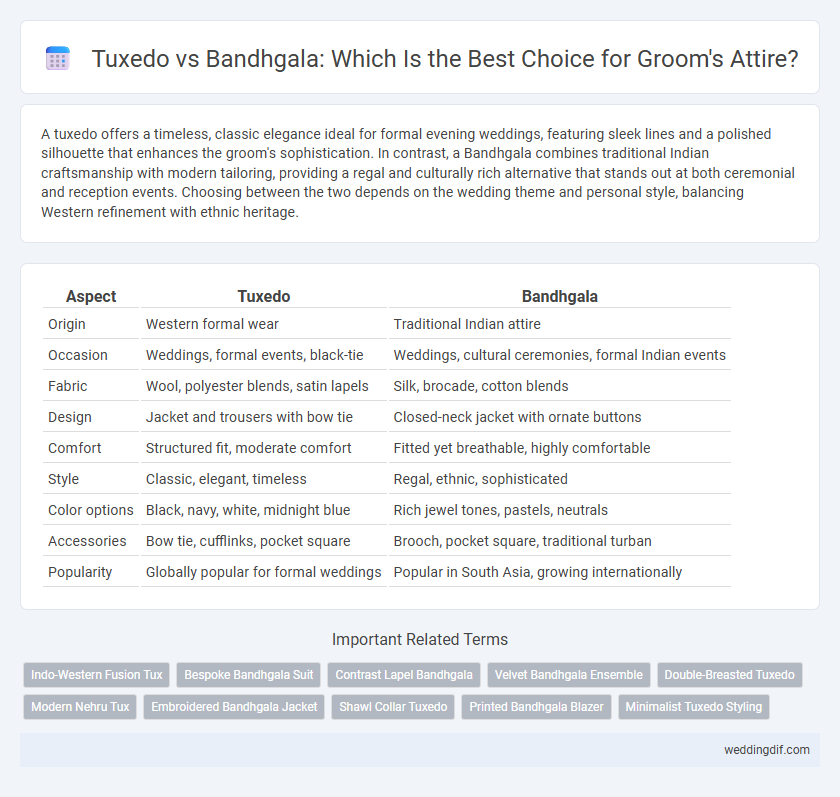A tuxedo offers a timeless, classic elegance ideal for formal evening weddings, featuring sleek lines and a polished silhouette that enhances the groom's sophistication. In contrast, a Bandhgala combines traditional Indian craftsmanship with modern tailoring, providing a regal and culturally rich alternative that stands out at both ceremonial and reception events. Choosing between the two depends on the wedding theme and personal style, balancing Western refinement with ethnic heritage.
Table of Comparison
| Aspect | Tuxedo | Bandhgala |
|---|---|---|
| Origin | Western formal wear | Traditional Indian attire |
| Occasion | Weddings, formal events, black-tie | Weddings, cultural ceremonies, formal Indian events |
| Fabric | Wool, polyester blends, satin lapels | Silk, brocade, cotton blends |
| Design | Jacket and trousers with bow tie | Closed-neck jacket with ornate buttons |
| Comfort | Structured fit, moderate comfort | Fitted yet breathable, highly comfortable |
| Style | Classic, elegant, timeless | Regal, ethnic, sophisticated |
| Color options | Black, navy, white, midnight blue | Rich jewel tones, pastels, neutrals |
| Accessories | Bow tie, cufflinks, pocket square | Brooch, pocket square, traditional turban |
| Popularity | Globally popular for formal weddings | Popular in South Asia, growing internationally |
Introduction to Groom’s Attire: Tuxedo vs Bandhgala
The tuxedo and bandhgala represent two distinct yet elegant choices for a groom's attire, each reflecting different cultural and stylistic elements. A tuxedo, characterized by its sleek silhouette, satin lapels, and classic black-and-white palette, embodies Western formalwear tradition perfect for evening weddings. In contrast, the bandhgala, also known as a Jodhpuri suit, is a traditional Indian ensemble featuring a tailored jacket with a high collar and intricate embroidery, symbolizing regal heritage and modern sophistication.
Historical Origins of the Tuxedo and Bandhgala
The tuxedo, originating in the late 19th century United States as a modern alternative to tailcoats, symbolizes Western formalwear elegance and sophistication. The bandhgala, also known as the Jodhpuri suit, traces back to 19th-century Rajasthan, India, blending regal Mughal influences with British colonial tailoring to create a distinctly royal silhouette. Both garments embody rich cultural histories that enhance the groom's attire with timeless tradition and refined style.
Key Differences in Design and Structure
Tuxedos feature a structured silhouette with satin lapels, typically crafted from wool or polyester blends, offering a classic Western formal look. Bandhgalas showcase a more tailored, mandarin-collared design with intricate embroidery or embellishments, reflecting traditional Indian aesthetics. The tuxedo emphasizes minimalist elegance, while the bandh gala highlights cultural richness and ornamental detailing.
Fabric and Material Choices for Both Styles
Tuxedos traditionally feature luxurious fabrics like wool, velvet, and satin, offering a smooth and polished finish ideal for formal evening weddings. Bandhgalas utilize rich materials such as silk, raw silk, and brocade, providing intricate textures and a regal appearance suited for cultural or daytime ceremonies. Both styles emphasize high-quality fabrics that enhance comfort and elegance, with tuxedos favoring sleek, glossy finishes and bandhgalas highlighting artisanal weaves and embellishments.
Formality and Occasion Suitability
A tuxedo offers a classic Western formal look ideal for black-tie weddings and evening events, emphasizing elegance and tradition. The bandhgala, a traditional Indian suit, suits daytime or cultural ceremonies with its regal style and intricate embroidery, blending formality with heritage. Choosing between the two depends on the event's dress code and cultural significance, ensuring the groom's attire aligns with the occasion's tone.
Regional and Cultural Relevance
Tuxedos represent Western formal wear often chosen for contemporary weddings, offering a sleek and classic silhouette favored in urban and global settings. Bandhgala suits hold cultural significance in South Asian weddings, particularly in India, symbolizing tradition and regional heritage with intricate embroidery and tailored fits. Selecting between a tuxedo and a bandhgala hinges on the wedding's cultural context, regional preferences, and the groom's personal connection to cultural identity.
Comfort and Fit Considerations
Tuxedos offer a structured fit with tailored silhouettes that provide timeless elegance, but may feel restrictive in warmer climates or extended wear. Bandhgalas, featuring a lighter, more breathable fabric and a close yet less rigid fit, enhance comfort without compromising style, especially suitable for traditional or outdoor weddings. Selecting between a tuxedo and bandhagala depends on prioritizing either classic Western formality or cultural authenticity balanced against comfort and fit preferences.
Styling Tips: Accessories and Footwear
For a tuxedo, select classic black patent leather shoes and pair with a sleek bow tie or a stylish cummerbund to enhance the formal silhouette. In contrast, a Bandhgala pairs well with mojari or mojaris and a pocket square or brooch to elevate its regal appeal. Consider cufflinks or a wristwatch to complement both styles, ensuring the accessories harmonize with the fabric and color of the attire.
Season and Weather Appropriateness
Tuxedos are ideal for cooler seasons and indoor evening weddings due to their heavy fabric and structured design, offering warmth and elegance. Bandhgalas are more versatile for mild to warm weather, as their lightweight material and breathable construction provide comfort while maintaining a regal appearance. Selecting between a tuxedo and bandhagala depends on climate, venue, and the groom's preference for temperature regulation and style.
Groom’s Personality and Style Statement
A tuxedo radiates timeless elegance and suits grooms seeking a classic, sophisticated look that highlights formal charm and confidence. The bandhgala, with its regal and culturally rich design, reflects a groom's pride in heritage and makes a bold style statement through intricate craftsmanship and unique silhouette. Choosing between a tuxedo and bandhgala ultimately depends on the groom's personality, whether he prefers Western refinement or traditional grandeur to express his individuality on the wedding day.
Tuxedo vs Bandhgala for groom's attire. Infographic

 weddingdif.com
weddingdif.com